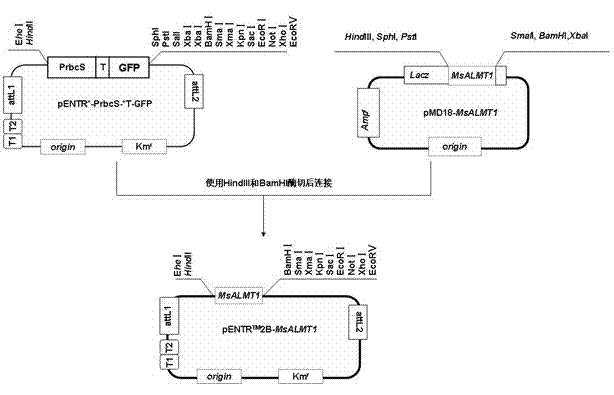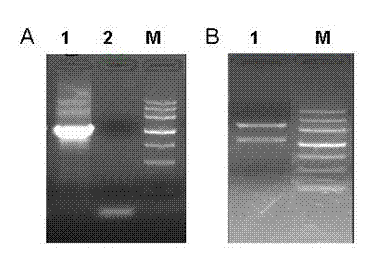Plant expression vector of alfalfa malic acid channel protein gene MsALMT1, and applications thereof
A plant expression vector and channel protein technology, which is applied to the plant expression vector of alfalfa malate channel protein gene MsALMT1, and the application field of transgenic plants, can solve the problems of limited and single plant sources, and achieve the goal of enhancing malic acid secretion Effect
- Summary
- Abstract
- Description
- Claims
- Application Information
AI Technical Summary
Problems solved by technology
Method used
Image
Examples
Embodiment 1
[0034] Example 1: MsALMT1 Gene cDNA amplification, TA cloning and sequence analysis
[0035] Since the model plant Alfalfa truncation and Medicago truncatula have high similarity, according to the gene sequence of the aluminum-induced malate channel protein of Alfalfa truncation published on NCBI ( MtALMT1 , ABD32183), the primers were designed as follows:
[0036] Upstream primer: 5′- GGATCC ATGGTGTCTGAACCAAATTCAAG-3'( Bam H I)
[0037] Downstream primer: 5'- AAGCTT TAGTTAATTATAATAACATGTTG-3'( Hind III)
[0038] Add the GGATCC characteristic sequence to the 5' end of the upstream primer, and thus form Bam H I restriction site; downstream primer 3' plus AAGCTT characteristic sequence, forming Hind III restriction site.
[0039] After aluminum-sensitive alfalfa YM1 was treated with aluminum for 24 hours, cut 0.1g root, grind it with liquid nitrogen, add 1ml TRIzoL extract, let it stand at room temperature for 5min, then transfer it to a centrifuge tube, then a...
Embodiment 2
[0041] Example 2: Construction of intermediate vector pENTR tm 2B- MsLAMT1
[0042] use Hind III and Bam H I Digest pMD18- MsALMT1 and pENTR*-PrbcS-*T- GFP carrier ( figure 2 ), separated the excised vector and insert by agarose gel electrophoresis, and recovered pMD18- MsALMT1 produced after being cut MsALMT1 Gene fragment (about 1.4kb) and pENTR*-PrbcS-*T- GFP The vector fragment pENTRTM2B generated after being cleaved, and then pENTRTM2B and MsALMT1 The DNA fragment of the gene produces the intermediate vector pENTRTM2B- MsALMT1 ( figure 2 ). Conversion of high efficiencies (10 8 ) Escherichia coli competent cells (DH5α, purchased from Tiangen Biochemical Technology Co., Ltd.), spread the transformed Escherichia coli on a plate added with kanamycin (Km, 50 μg / ml), and cultivate overnight at 37°C. Screen the Km-resistant recombinant colony, extract the plasmid from the Km-resistant recombinant colony, and select the successfully connected plasmid vector...
Embodiment 3
[0043] Example 3: Plant expression vector pK2-35S- MsALMT1 build
[0044] Through the LR response of Gateway technology, the MsALMT1 Subcloned into the plant expression vector pK2GW7 (Gateway's destination vector, Belgium VIB / Gent company). The specific method is: use the plasmid extraction kit to purify Gateway's destination vector pK2GW7 ( Figure 6 A), add pENTRTM2B- to Gateway's LR reaction system MsALMT1 and pK2GW7 each 150ng, 1μl LR Clonase II Enzyme Mix (Invitrogen), mix well and react overnight at 25°C, through the action of integrase MsALMT1 Integrate into pK2GW7 to obtain MsALMT1 The plant expression vector pK2-35S- MsALMT1 ( Figure 5 ). Conversion of high efficiency (10 8) Escherichia coli competent cells (DH5α, purchased from Tiangen Biochemical Technology Co., Ltd.), spread the transformed Escherichia coli on a plate added with spectinomycin (Spe, 50 μg / ml), cultivate overnight at 37°C, and screen Spe-resistant recombinant colonies. Plasmids were extr...
PUM
 Login to View More
Login to View More Abstract
Description
Claims
Application Information
 Login to View More
Login to View More - R&D
- Intellectual Property
- Life Sciences
- Materials
- Tech Scout
- Unparalleled Data Quality
- Higher Quality Content
- 60% Fewer Hallucinations
Browse by: Latest US Patents, China's latest patents, Technical Efficacy Thesaurus, Application Domain, Technology Topic, Popular Technical Reports.
© 2025 PatSnap. All rights reserved.Legal|Privacy policy|Modern Slavery Act Transparency Statement|Sitemap|About US| Contact US: help@patsnap.com



